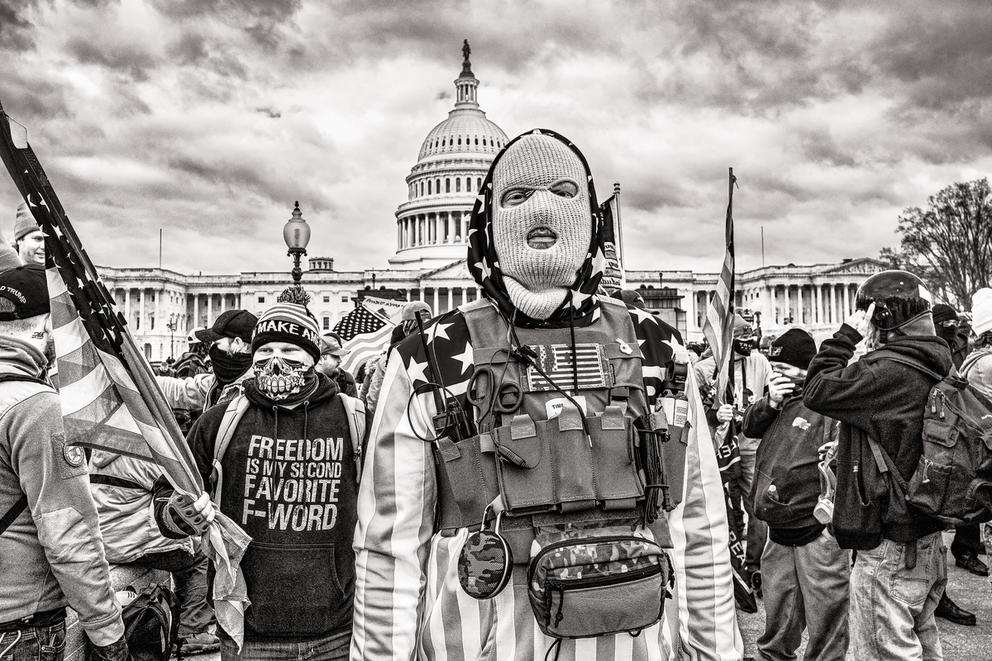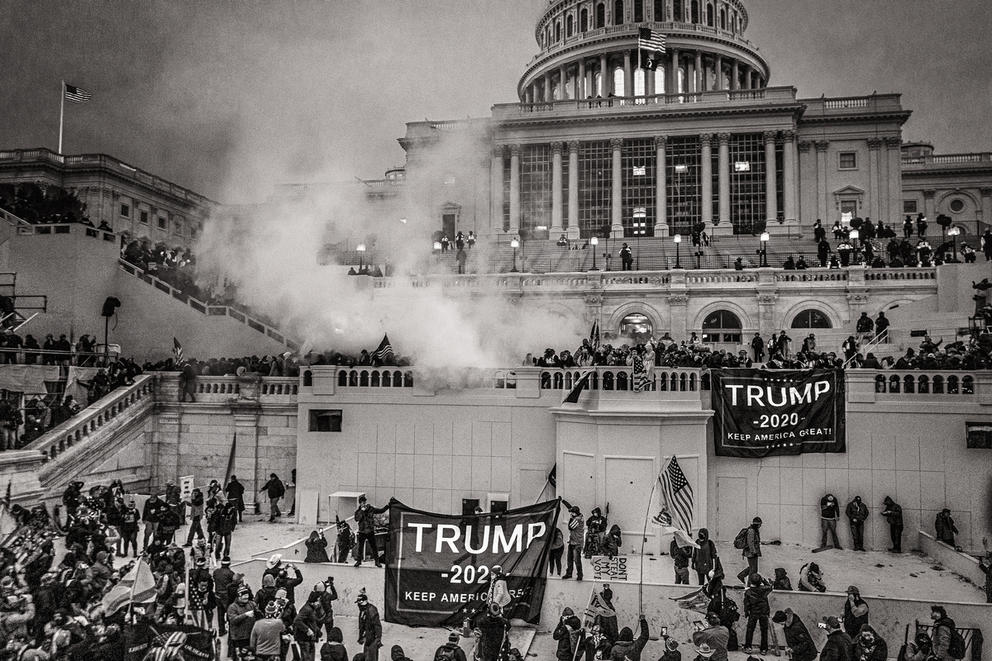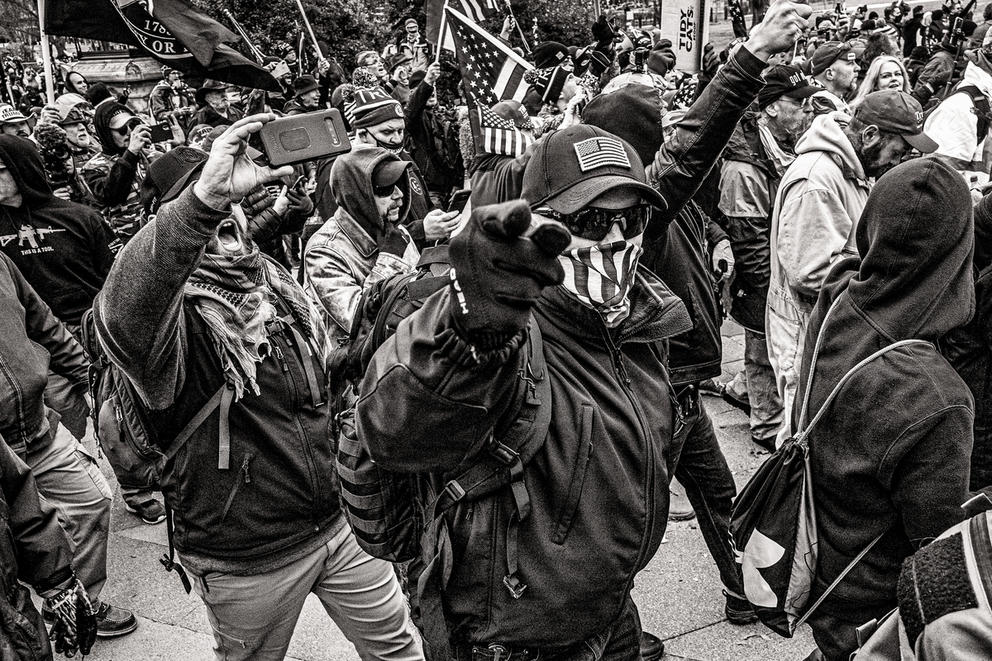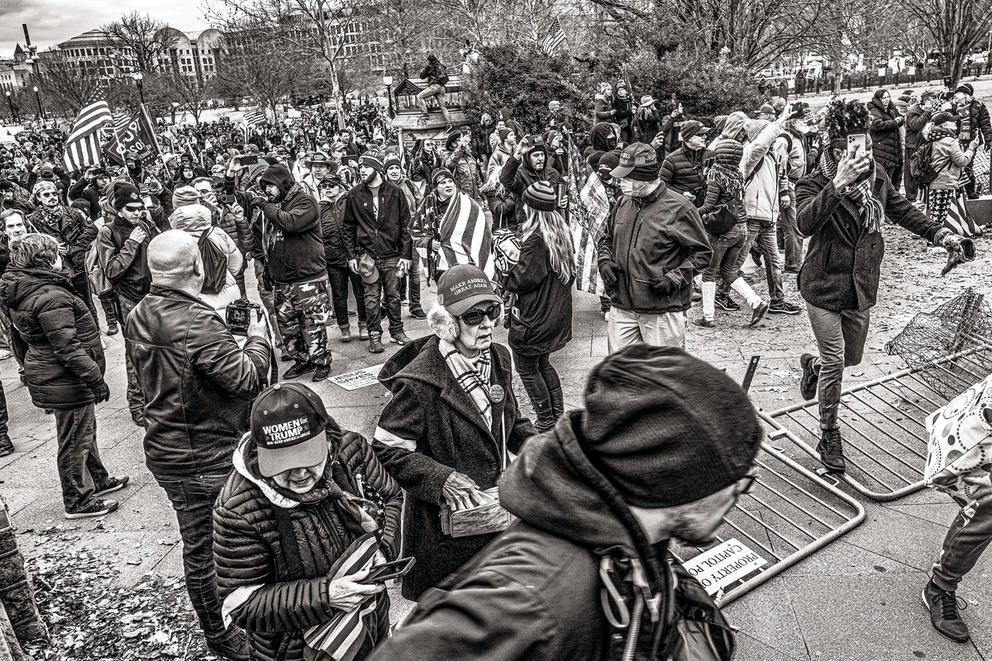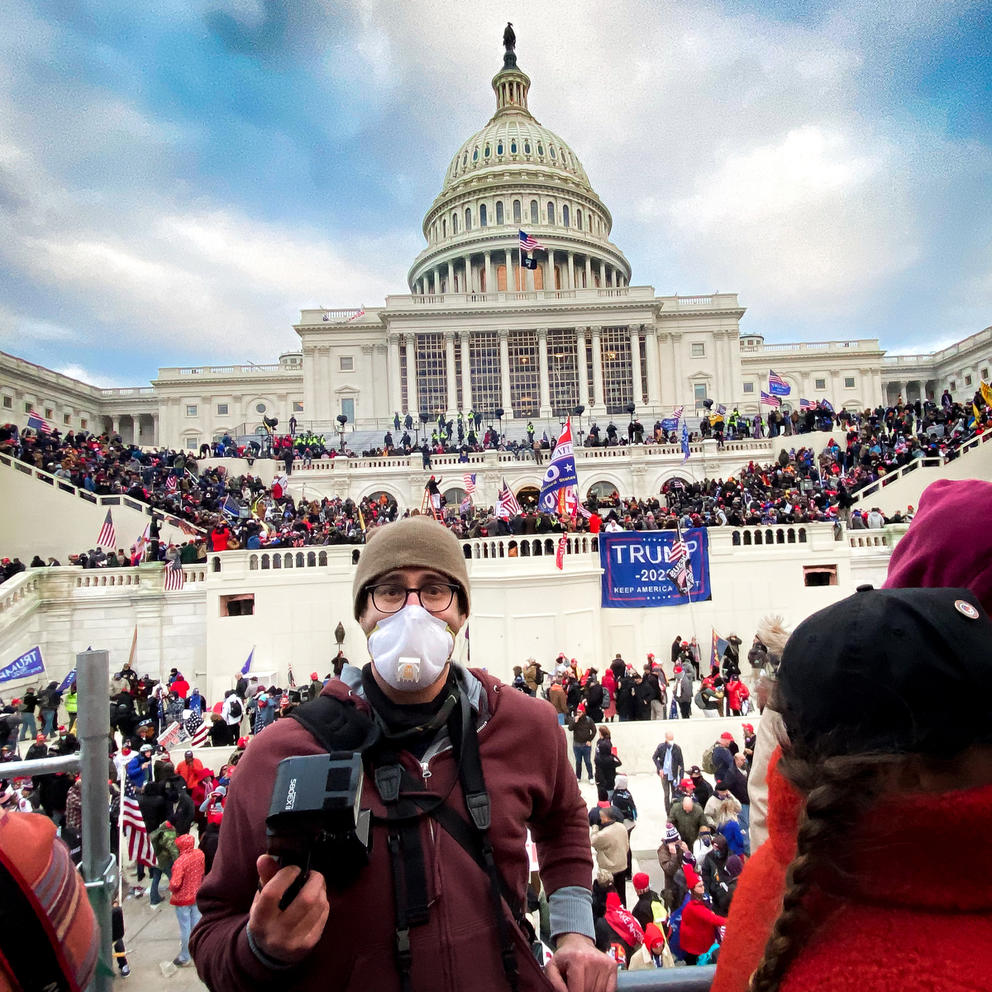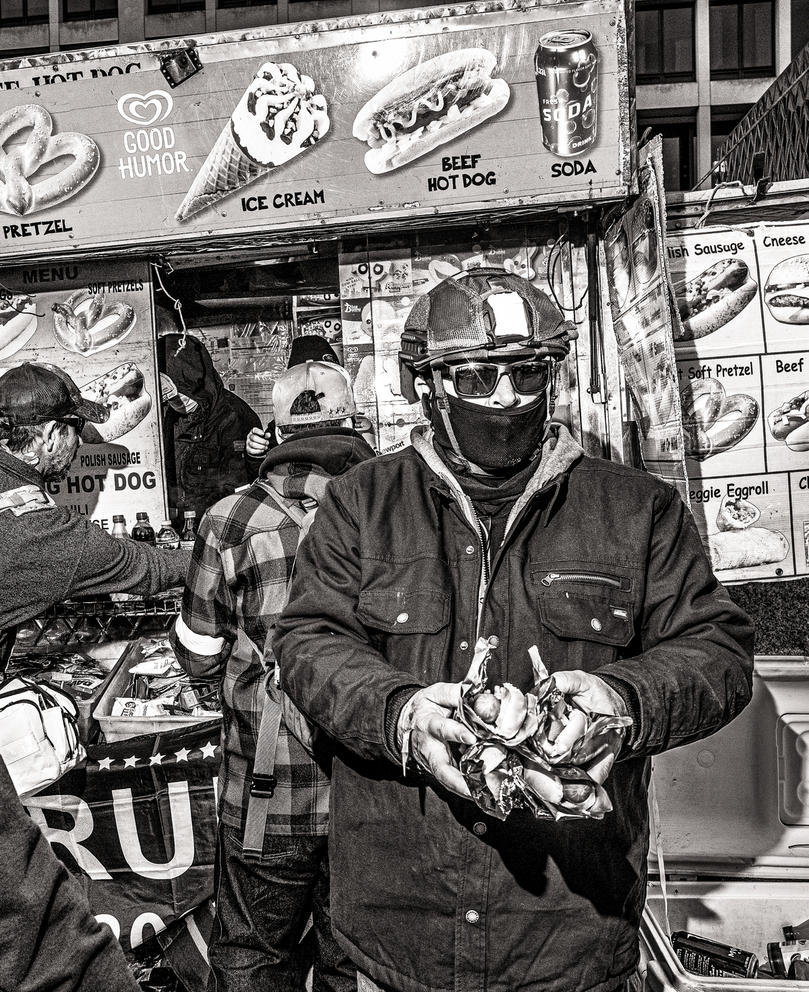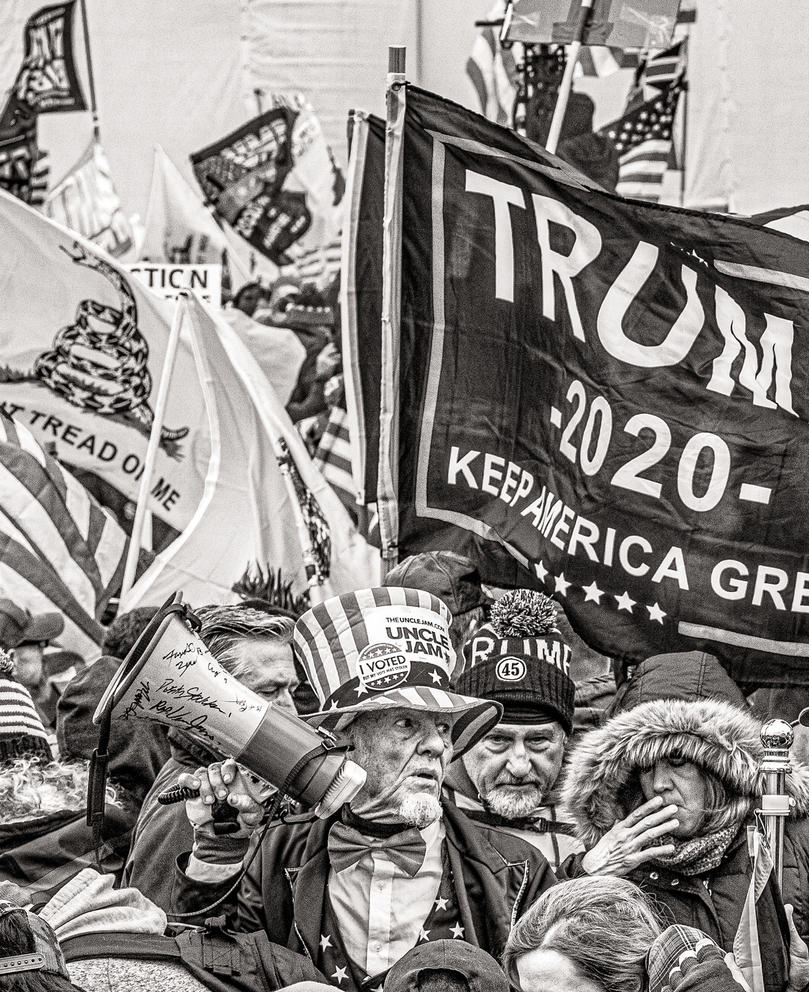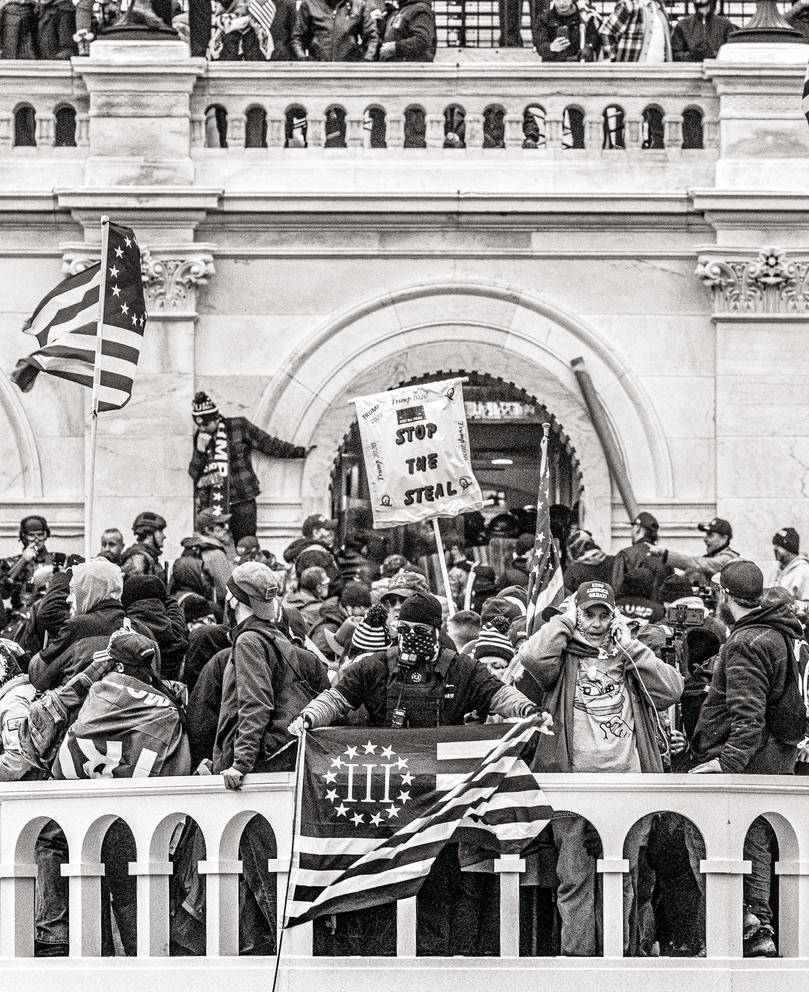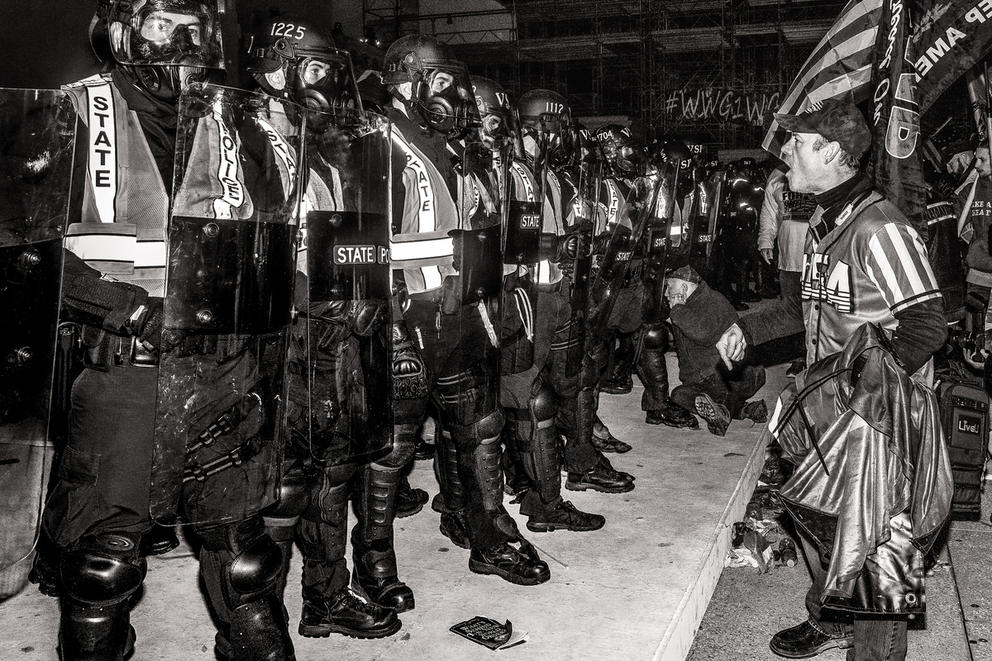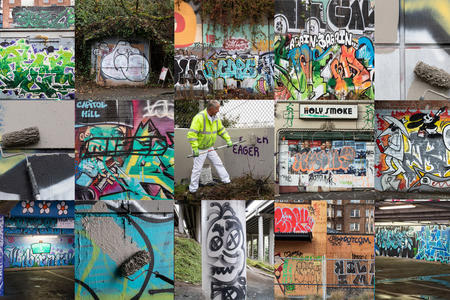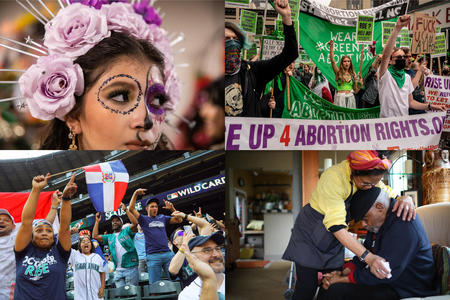Gowdy was on the plane to cover the rally for Rolling Stone — a big-deal assignment, but not that different from the hundreds of political rallies he’d covered in his career. And then the chanting started. “The MAGA people kept assaulting our ears with chants of ‘USA, USA!’ and ‘Trump!’ and ’Four More Years,’” he recalls. “That’s when I knew this one was going to be different.”
His hunch was right: On that day, thousands of Trump supporters — emboldened by Trump’s false claims of election fraud — descended on the Capitol and broke through police barricades. Hundreds of rioters assaulted the Capitol police force and broke into the building and Senate chamber, forcing members of Congress to evacuate, lock themselves in secure areas or flee to underground bunkers. What would later be called the worst attack on Congress in centuries and an unprecedented assault on American democracy left at least five people dead and hundreds of police officers injured.
Now, on the second anniversary of the riot and on the heels of the release of the final Jan. 6 House committee report, Gowdy is releasing a self-published book titled Insurrection. It features more than a hundred photos he took that day, expanding on the initial 25-photo series published in Rolling Stone on January 7. (The book’s first, soft-cover edition of 666 copies sold out this past summer.) In the new hardcover book, Gowdy chronicles the chaos of that day in dramatic, stark black-and-white photos and a first-person narrative that puts the reader, like Gowdy, into the middle of the chaos and commotion.
In an interview with Crosscut, Gowdy talked about being at the Capitol on the fateful day. “It resembled a high school pep rally gone way wrong — the adrenaline and the toxic masculinity,” Gowdy says. “The war cries.”
Because the book follows the chronology of Gowdy’s day, it reads like a page-turner — one in which you already know the grim ending. Red timestamps, stylized like an LCD alarm-clock font, add to the tension.
The action starts at 10:41:23 a.m. on Jan. 6 as Gowdy makes his way across the lawn to the Ellipse, where Trump is scheduled to speak at noon. He quickly runs into a contingent of Proud Boys. “Something was up,” Gowdy recalls. “Trump hadn’t even spoken yet at his rally and they are walking away from the rally — like kids who ditched class and were up to no good.”
And then, a protester in a Trump beanie lunges at him. Gowdy releases the shutter of his Leica Q camera as it happens. The harsh flash reflects off the man’s sunglasses, which, combined with the bandana covering the bottom half of his face, render him a frightening, faceless danger. In the background, out of the photo’s focus, multiple men look in the camera’s direction. One has his finger pointed in Gowdy’s direction, his mouth open mid-shout.
“Antifa!” and "Fake News!” Gowdy remembers the group yelling after he told them he was a press photographer. “I have grown accustomed to being leered at during hard-right outings, but never to this degree,” he writes in the book.
The captions, while brief, are helpful in moving the narrative of Insurrection along, providing context that photos can’t always capture (including smells, like the “breeze tainted with flash-bang smoke and caustic chemicals”) and insight into Gowdy’s thinking — and his own disbelief at what is happening.
Some of the action seemed surreal to Gowdy: such as the moment a group of extremists knelt to pray. Or when the men — dressed in ballistic helmets and tactical gear — broke for lunch to eat hot dogs and tacos.
And then the mood shifted, Gowdy says. The group marched to the Peace Monument and approached the Capitol building, where U.S. Capitol Police stood inside a perimeter of metal barricades.
12:55:13 PM: As they are promptly overpowered, I am caught in a melee of war cries, adrenaline, and suddenly surging bodies. The insurrection has begun.
While many of Gowdy’s photos brim with anger and emotion, his shot of the moment of the breach is surprisingly — almost comically — banal. One person seems to jog straight over and on top of the downed fences, while holding up his phone. Someone who appears to be carrying a shopping bag walks out of the frame toward the Capitol. An older woman wearing a Make America Great Again hat and earmuffs casually walks past the barricades as a crowd of hundreds waits in the background.
When a protester attacked Gowdy, shoving him from a balustrade, “a fair amount of people stopped to make sure I was okay,” Gowdy says. “You have this mix of militants and people who are just out there to support their president. But, around 12:55 when the 'no trespassing' steel barriers were breached, that’s when these people exercising their First Amendment rights crossed a hard line and, well, it became insurrectionist.” (Nate Gowdy)
Most of the photos in the book were shot wide with a fixed 28 mm lens, giving them an “in the middle of the action” feel. The stark black and white lends them a patina, an intentional homage to the news photography of the 1960s and ’70s Gowdy is inspired by.
Gowdy often works in color — for pieces in Rolling Stone and Mother Jones; his 2016 portrait of Bernie Sanders on the cover of TIME; and “The American Superhero Project.” But he prefers black and white, particularly for his political assignments and self-funded photography of rallies and political events.
In those series, including Insurrection, Gowdy’s work dips from photojournalism into fine arts photography: It’s dramatic, starkly contrasted black and white — and has a strong point of view. This comes through in Gowdy’s captions as well, when he at times veers into commentary or outright partisanship, such as calling Trump “Drumpf.”
While he says he photographs people the same way no matter where they land on the sociopolitical spectrum, he also believes these extraordinary times call for a more opinionated approach. “I think now’s the time to speak up,” Gowdy says. “This is Christo-fascism … I don’t think it is a ‘both sides’ thing here: One side is being radicalized. And the other side is sane.”
That radicalization, Gowdy says, has extended to the belief the news media are the enemy of the people. Case in point: At one moment on Jan. 6, a man, realizing Gowdy was a photojournalist, shoved him from a three-foot balustrade at the base of the Capitol stairs leading toward the Inauguration Day stage. After that, Gowdy decided to keep a lower profile: He lowered his camera and turned off his flash. He started taking photos from the hip to be as discreet as possible.
January 6 was, according to experts, an inflection point for attacks on the media. The U.S. Press Freedom Tracker documented 18 journalists assaulted during the riots and tens of thousands of dollars of news equipment damaged.
“The events of Jan. 6 in Washington crystalized the worsening atmosphere and threat to journalists in the United States from political extremists and conspiracy theorists,” the International Press Institute wrote in a 2021 blog post about rising violence against reporters in the U.S. “Words that were written on a door of the U.S. Capitol, ‘Murder the media,’ by some of the armed protesters were a stark and frightening warning to all of us,” the blog post continued.
On that day in January, Gowdy witnessed a group of men attack photojournalist John Minchillo of the AP. Stuck in the crowd, he writes, he looked on helplessly “as the Associated Press staffer is thrown from a roughly five-foot-high retaining wall and escorted from the scene by the neck of his jacket.”
As a section of the mob broke into the Capitol, Gowdy continued to capture the chaotic scenes on the Capitol’s western terraces, surrounded by clouds of teargas, flags, fists and chants like “Hang Mike Pence!” In one photo — a baroque tableau of bodies crowding together under outstretched flags in a pyramidal structure — a man uses his scarf to assuage the burning teargas. It looks like he is crying. Gowdy didn’t know it (his phone signal was very weak) but by that time, Congress had gone into recess and its members into hiding. Shortly after, a dispersal order was announced and the National Guard stepped in.
5:51:42 PM: A photo, somewhat blurry, shows police in riot gear with their batons at the ready, the illuminated Capitol dome contrasting white against the dark evening sky. Gowdy writes:
This blurry frame is a representation of how I feel. Hungry. Dehydrated. Exhausted. I am ready to walk the several miles to a friend’s apartment to begin my photo edits, due to Rolling Stone in the morning. Mayor Muriel Bowser’s citywide curfew goes into effect at 6 PM. At 6:01 PM, Trump tweets for the last time: “These are the things and events that happen when a sacred landslide election victory is so unceremoniously & viciously stripped away from great patriots who have been badly & unfairly treated for so long. Go home with love & in peace. Remember this day forever!”

